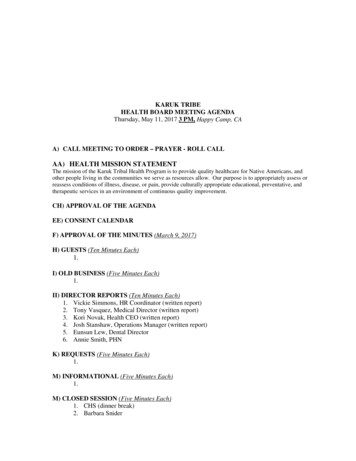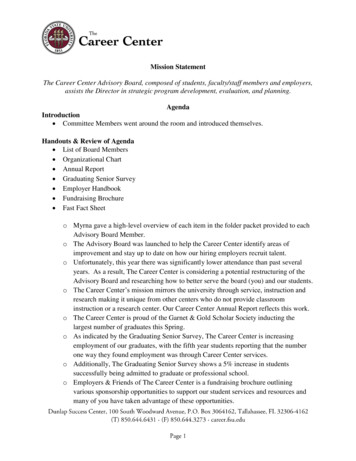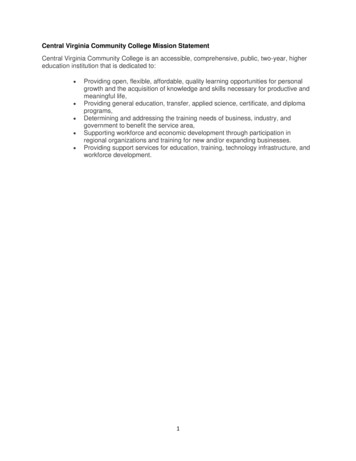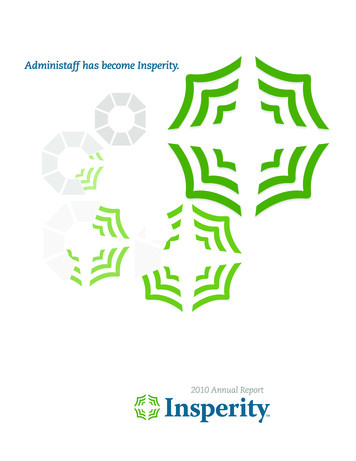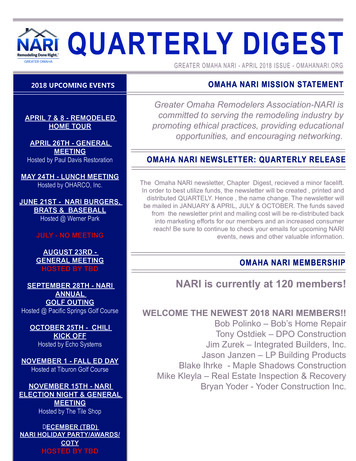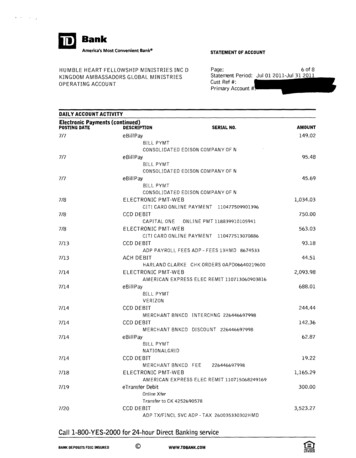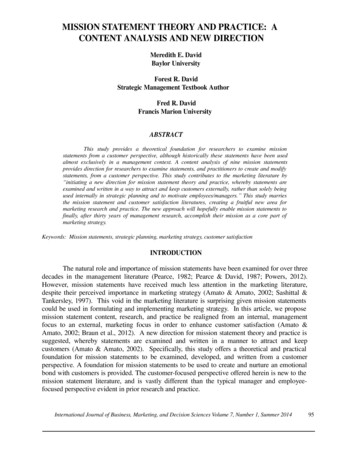
Transcription
MISSION STATEMENT THEORY AND PRACTICE: ACONTENT ANALYSIS AND NEW DIRECTIONMeredith E. DavidBaylor UniversityForest R. DavidStrategic Management Textbook AuthorFred R. DavidFrancis Marion UniversityABSTRACTThis study provides a theoretical foundation for researchers to examine missionstatements from a customer perspective, although historically these statements have been usedalmost exclusively in a management context. A content analysis of nine mission statementsprovides direction for researchers to examine statements, and practitioners to create and modifystatements, from a customer perspective. This study contributes to the marketing literature by“initiating a new direction for mission statement theory and practice, whereby statements areexamined and written in a way to attract and keep customers externally, rather than solely beingused internally in strategic planning and to motivate employees/managers.” This study marriesthe mission statement and customer satisfaction literatures, creating a fruitful new area formarketing research and practice. The new approach will hopefully enable mission statements tofinally, after thirty years of management research, accomplish their mission as a core part ofmarketing strategy.Keywords: Mission statements, strategic planning, marketing strategy, customer satisfactionINTRODUCTIONThe natural role and importance of mission statements have been examined for over threedecades in the management literature (Pearce, 1982; Pearce & David, 1987; Powers, 2012).However, mission statements have received much less attention in the marketing literature,despite their perceived importance in marketing strategy (Amato & Amato, 2002; Sashittal &Tankersley, 1997). This void in the marketing literature is surprising given mission statementscould be used in formulating and implementing marketing strategy. In this article, we proposemission statement content, research, and practice be realigned from an internal, managementfocus to an external, marketing focus in order to enhance customer satisfaction (Amato &Amato, 2002; Braun et al., 2012). A new direction for mission statement theory and practice issuggested, whereby statements are examined and written in a manner to attract and keepcustomers (Amato & Amato, 2002). Specifically, this study offers a theoretical and practicalfoundation for mission statements to be examined, developed, and written from a customerperspective. A foundation for mission statements to be used to create and nurture an emotionalbond with customers is provided. The customer-focused perspective offered herein is new to themission statement literature, and is vastly different than the typical manager and employeefocused perspective evident in prior research and practice.International Journal of Business, Marketing, and Decision Sciences Volume 7, Number 1, Summer 201495
The content analysis of real mission statements provided herein yields both research andpractical guidelines for firms to create, modify, and use their mission statement to improvecustomer satisfaction. Toward this end, actual mission statements are critiqued from a customerperspective, and new, exemplary statements are proposed for several firms. It is anticipated thatreveal how future raters (researchers) could examine the extent that statements are written from acustomer perspective. In total, we anticipate the new, customer-focused, rather thanmanager/employee-focused, approach to mission statement research and practice will enablethese statements to finally fulfill their potential as a core part of marketing strategy (Smith et al.,2001).This study marries the mission statement and customer satisfaction literatures, creating afruitful new area for marketing research and practice. The new approach will hopefully enablemission statements to finally, after thirty years of management research, accomplish theirmission as a core part of marketing strategy.LITERATURE REVIEWMission Statements in ManagementCurrent thought on mission statements is based largely on guidelines set forth in the mid1970s by Peter Drucker (1974, p. 61), who is often called “the father of modern management.”Drucker says asking the question “What is our business?” is synonymous with asking thequestion “What is our mission?” A mission statement is a declaration of an organization’s“reason for being” and distinguishes one organization from other similar enterprises (Campbell& Yeung, 1991; Pearce, 1982; Pearce & David, 1987).Various benefits of having a clear mission statement are provided in the managementliterature (Analoui & Karami, 2002; Atrill, Omran, & Pointon, 2005; Bart & Baetz, 1996; Braun,et. al., 2012). For example, King and Cleland (1979, p. 88) recommend that organizationscarefully develop a written mission statement in order to reap the following benefits: 1) makesure all employees and managers understand the firm’s purpose or reason for being; 2) provide abasis for prioritization of key internal and external factors utilized to formulate feasiblestrategies; 3) provide a basis for the allocation of resources; and 4) provide a basis for organizingwork, departments, activities, and segments around a common purpose.Overall, themanagement literature suggests that carefully prepared mission statements are widely recognizedby both practitioners and academicians as the first step in strategic management, such that a clearmission statement is essential for effectively establishing objectives and formulating strategies(Collins & Rukstad, 2008; David, 1989; Powers, 2012).Mission statements have been examined as a key indicator of organizational performance(Atrill, Omran, & Pointon, 2005; Bart & Baetz, 1998; Desmidt, Prinzie, & Decramer, 2011;Palmer & Short, 2008; Rarick & Vitton, 1995). However, research results are mixed regardingtheir impact on firm performance (Atrill, Omran, & Pointon, 2005; Collins & Rukstad, 2008;Palmer & Short, 2008). A meta-analysis of 20 years of empirical research on missionstatements, concluded “there is a small positive relation between mission statements andmeasures of financial organizational performance,” but the exact magnitude of the relationship isinfluenced by operationalization decisions (Desmidt, Prinzie, & Decramer, 2011, p. 468).Overall, the management literature suggests that the relationship between mission statements and96International Journal of Business, Marketing, and Decision Sciences Volume 7, Number 1, Summer 2014
organizational performance is quite weak (Desmidt, Prinzie, & Decramer, 2011). However,extant literature in marketing explains that customer satisfaction has a strong positiverelationship with organizational performance (Devasagayarm, Stark, & Valestin, 2013;Lundberg, 1984; Luo, Wieseke, & Homburg, 2012).Indeed, researchers have noted that“managers increasingly tend to see customer satisfaction as a valuable intangible asset and thusas an important corporate target” (Luo, Wieseke, & Homburg, 2012, p. 745). Similarly, Valentin(1996, p. 16) said: “entire business organizations, not just marketing departments, should becustomer oriented.” Extant literature suggests that mission statement can and should be used tocreate an “emotional bond” and “sense of mission” between an organization and its employees(Campbell & Yeung, 1991). Thus, and as discussed next, we infer that customer-centeredmission statements, designed from a customer perspective, could positively impactorganizational performance by enhancing customer satisfaction (Rarick & Vitton, 1995).Marketing ConsiderationsAlthough examined and researched predominantly in the management literature, missionstatements are considered to be important in marketing strategy and planning (Sashittal &Tankersley, 1997; Valentin, 1996). The American Marketing Association (AMA) definesmission statement as “an expression of a company’s history, managerial preferences,environmental concerns, available resources, and distinctive competencies to serve selectedpublics used to guide a firm’s decision-making and strategic planning.” Largely because missionstatements have historically lacked a customer perspective, customers of many firms often do notknow whether the firm has a statement (Bart & Baetz, 1996; Bartkus, Glassman, & McAfee,2000; Collins & Rukstad, 2008); the present paper aims to change this business reality.All marketing activities involving direct or indirect contact with customers can beenhanced when those endeavors are based on a firm’s basic mission (Amato & Amato, 2002).Since consumer needs and desires are at the core of marketing strategy, the authors of this studyanticipate that mission statements written from a customer perspective could help with theimplementation of marketing strategy. Effective marketing hinges on a firm communicating itsoverarching purpose and competitive advantage; mission statements can be helpful in this regard.A clear sense of business mission is arguably the foundation for communication with customers.Mission statements could be an important basis for marketing communication with outside-thefirm constituencies, especially customers (Amato & Amato, 2002; Desmidt, Prinzie, &Decramer, 2011; Sidhu, 2003). For example, a customer-centered mission statement may enablea firm to more effectively engage in advertising, promoting, publicity, selling, and othermarketing activities to induce customers to develop an attachment, connection, or bond with thefirm (Dagger & David, 2012; Sashittah & Tankersley, 1997).Managers from various functional areas and levels of the firm should be included indevelopment and modification of a corporate mission statement (Braun et al., 2012). Marketingsales representatives and managers should have input into devising and writing the statement tobest assure that marketing goals, such as enhancing customer satisfaction and providingexemplary customer service, are included (Rego, Morgan, & Fornell, 2013). Historically,however, marketers are most often not involved, partly because the statements (and prior relatedresearch) lack a customer perspective.The process by which mission statements are developed and the exact language/wordingincluded in the statement can significantly impact their effectiveness as a tool for strategicInternational Journal of Business, Marketing, and Decision Sciences Volume 7, Number 1, Summer 201497
management and marketing strategy (Kemp & Dyer, 2003).Ideally, firms strive to havecustomers exhibit an emotional bond with the firm’s products/services and be “on a mission” touse and promote those offerings (Rego, Morgan, & Fornell, 2013). For example, many of Avonand L’Oreal’s customers today portray an emotional bond or attachment with the firm.(Proposed mission statements for these two firms are examined later in this paper). As anextension of prior research, we propose that mission statements be developed and used to fostercustomer satisfaction and create a bond between a firm and its customers. Involving marketersand sales representatives in the mission statement development process, coupled with includingthe appropriate content, could enable firms to create an emotional bond with customers, andenhance the likelihood that salespersons would be “on a mission” to provide excellent customerservice.Appropriately written, mission statements could reassure constituencies that the firm iscustomer focused and driven (Devasagayam, Stark, & Valestin, 2013). If written from acustomer perspective, mission statements could spur employees, salespersons, and managers toprovide exemplary customer service, which arguably would enhance customer loyalty, andtranslate into customers being “on a mission” to seek out, use, and promote the firm’s productsand services (Luo, Wieseke, & Homburg, 2012; Bart & Baetz, 1996). If written from a customerperspective, mission statements perhaps may accomplish their mission (Smith, et. al. 2001), bemore than smoke and mirrors (Bartkus, Glassman, & McAfee, 2000), contribute to customersatisfaction (Devasagayam, Stark, & Valestin, 2013), and positively impact organizationalperformance (Peyrefitte & David, 2006).Characteristics and ComponentsMission statements can and do vary in length, content, format, and specificity (Kemp &Dwyer, 2003; Palmer & Short, 2008; Smith et al., 2001). However, mission statements should beinformative, inspiring, enduring, concise, clear, and conducive to both employees and customersforming an emotional bond with the firm. Specifically, prior research suggests that a missionstatement is most effective when it is approximately 100 words in length, and when it avoidsinclusion of monetary amounts, numbers, percentages, ratios, or objectives (David & David,2003; Davies & Glaister, 1997; Kemp & Dwyer, 2003).Most practitioners and academicians of strategic management assert that an effectivemission statement should include nine components: 1) customers, 2) products or services, 3)markets, 4) technology, 5) concern for survival, growth, and profitability, 6) philosophy, 7) selfconcept, 8) concern for public image, and 9) concern for employees (Baetz & Bart, 1996;O’Gorman & Doran, 1999; Pearce & David, 1987). However, our review of the extant literaturereveals that prior research has not examined whether the nine components are written from acustomer perspective. No prior findings address the potential positive aspects of customeroriented statements (McGinnis, 1981; Powers, 2012). Despite this specific void in the literature,we extrapolate from prior research that the nine components, written from a customerperspective, could individually and collectively enable mission statements to be used as a basisfor marketing communication with customers (Amato & Amato, 2002; Powers, 2012; Rego,Morgan, & Fornell, 2013). The content of a firm’s mission statement does matter and couldrepresent a competitive advantage or disadvantage for a firm (Peyrefitte & David, 2006; Smith etal., 2001).98International Journal of Business, Marketing, and D
International Journal of Business, Marketing, and Decision Sciences Volume 7, Number 1, . management and marketing strategy (Kemp & Dyer, 2003). Ideally, firms strive to have customers exhibit an emotional bond with the firm’s products/services and be “on a mission” to use and promote those offerings (Rego, Morgan, & Fornell, 2013). For example, many of Avon and L’Oreal’s customers .
